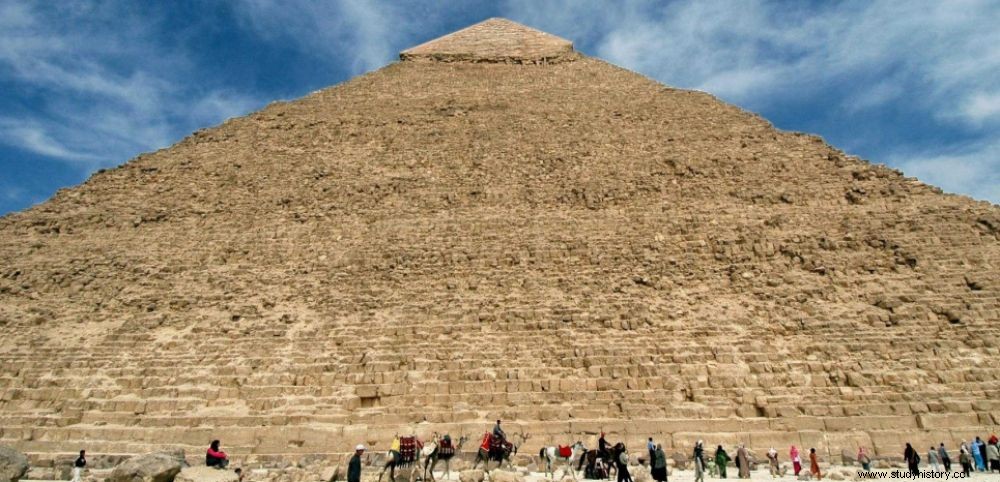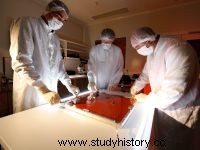The Atomic Energy and Alternative Energies Commission joins the ScanPyramids campaign in its project to explore the Egyptian pyramids.

The pyramid of Chephren, on the Giza plateau, in Egypt.
EXPLORATION. The flagship of French fundamental physics at the foot of the pyramids! Who would have imagined it? This improbable meeting has just been made official:ScanPyramids announced on Friday, April 15, 2016 that the CEA (Commissariat for Atomic Energy and Alternative Energies) has joined it in its project to explore the great funerary monuments of ancient Egypt. . Since October 25, 2015, ScanPyramids, a mission launched by the Faculty of Engineering of Cairo University and the HIP Institute (Heritage Innovation Preservation) under the authority of the Egyptian Ministry of Antiquities, mobilizes non-invasive high-tech techniques in order to reveal, in Cheops and Chephren at Gizeh, the rhomboidal pyramid and the red pyramid at Dahshur, unknown structures. Alongside infrared thermography and 3D reconstruction, the team has opened up another particularly fascinating field of vision:it involves using cosmic particles, the muons which fall permanently on the earth and are capable of to cross very thick rocks, to X-ray the monuments in depth. Thus, for forty days between January and February 2016, the team of Professor Kunihiro Morishima, from the University of Nagoya (Japan) placed forty muon sensors based on chemical emulsions in the lower chamber of the pyramid. rhomboidal. The results are at the end of the analysis and already show that the technique works well for monuments as massive as the pyramids.
ScanPyramids Q1 2016 Video Report (Muons Techniques) from HIP Institute on Vimeo.
A whole new kind of muon telescopes
The CEA, and more particularly the Irfu (Institute for research on the fundamental laws of the universe), now more than completes the system. Because his team, led by Sébastien Prosecutor, in charge of scientific mission, has developed specially for ScanPyramids muon telescopes of an entirely new type, adapted from detectors used in high-energy physics experiments:Micromegas. Invented and perfected in the Saclay laboratories, they are gas-based, more precisely argon:by passing through the sensors, the muons ionize the gas and generate electron-ion pairs which allow their trajectory to be followed (see technical box below below).
"One of the objectives of ScanPyramids is to offer a field of experimentation and evolution to innovative technologies which, for some, have just come out of research laboratories, explains Mehdi Tayoubi, co-director of the ScanPyramids mission.We are very excited at the idea of welcoming Sébastien Prosecutor's team:he admitted to me that he dreamed, as a child, of making glasses to see at through the pyramids while reading a comic" . Three detectors are being assembled and tested in the Irfu laboratories. All should discover the sands of the Egyptian desert before the end of April 2016. The first will embark for Cairo next week. The members of the team baptized it Alvarez… After the name of Luis Walter Alvarez, American Nobel Prize in physics, specialist in cosmic rays who, in the 1960s, undertook… to unravel the mysteries of Chephren thanks to muons! Finally fundamental physics and pyramids were made to meet!
THE TELESCOPE TECHNIQUE. 4 Micromegas detectors filled with an argon-based gas are assembled in line on a structure that will act as a telescope. The muons arrive on the first. They ionize the argon, generating electron-ion pairs, which are picked up by the device's electronics via copper micro-tracks. The muons continue their course through the next three detectors. At the other end of the telescope, a nano-PC records the accumulated raw data, from which it calculates the impact position of the muons on the plates. This pre-calculation makes it possible to considerably reduce the quantity of data generated by the telescope, and to transmit them by a simple 3G key to the Saclay laboratory where they will then be analyzed in order to reconstruct the trajectory of the particles. Thanks to argon cylinders, the detectors can be recharged, which is sometimes necessary because the device is not completely waterproof. The set consumes very little (30 W, the equivalent of a light bulb!) and operates using a battery of the type used in trucks.
This muon tracker developed by the CEA scans the Egyptian pyramids



